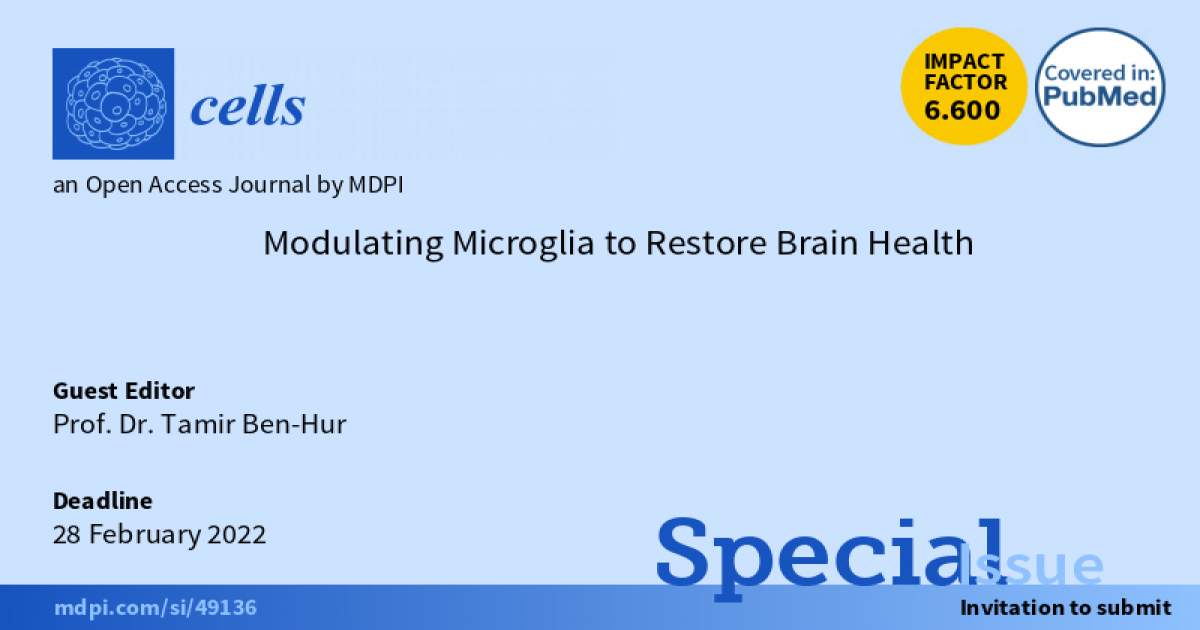Modulating Microglia to Restore Brain Health
A special issue of Cells (ISSN 2073-4409). This special issue belongs to the section "Cells of the Nervous System".
Deadline for manuscript submissions: closed (28 February 2022) | Viewed by 29105

Special Issue Editor
Special Issue Information
Dear Colleagues,
Microglia are emerging as key players in the pathogenesis of multiple neuro-degenerative and chronic neuro-inflammatory diseases, such as Alzheimer’s disease, other dementias, and chronic progressive multiple sclerosis. There is accumulating data to suggest the existence of two competing populations of microglia: one of overactivated and neurotoxic microglia which promote the loss of synapses and neurons; the other of neuroprotective, pro-regenerative microglia, which limit disease progression and support a healing brain environment.
Many open issues remain to be answered:
- What is the relationship between these two cell populations, and to resting, homeostatic microglia?
- Do neurotoxic and neuroprotective microglia emerge from a common cell population, representing marked plasticity? This may open the possibility of therapeutic modulation to switch their phenotype. Alternatively, do they develop from different pre-existing subtypes that need to be targeted differentially?
- What are the bilateral relationships between microglia and other brain cells? How do microglia affect the function of neurons and glia, and how do brain cells affect microglial phenotype and function?
- How can known and unknown signaling pathways in microglia be manipulated to restore a healthy brain environment?
- How does the systemic immune system cross-talk with brain microglia? Specifically, how do peripheral myeloid cells of the innate immune system, and cells of adaptive immunity affect microglial function and brain health in these diseases?
- What differs between disease-promoting microglia in neurodegenerative diseases versus disease-promoting microglia in functional brain disorders such as depression?
These questions and others will be the focus of this Special Issue of Cells.
Prof. Tamir Ben-Hur
Guest Editor
Manuscript Submission Information
Manuscripts should be submitted online at www.mdpi.com by registering and logging in to this website. Once you are registered, click here to go to the submission form. Manuscripts can be submitted until the deadline. All submissions that pass pre-check are peer-reviewed. Accepted papers will be published continuously in the journal (as soon as accepted) and will be listed together on the special issue website. Research articles, review articles as well as short communications are invited. For planned papers, a title and short abstract (about 100 words) can be sent to the Editorial Office for announcement on this website.
Submitted manuscripts should not have been published previously, nor be under consideration for publication elsewhere (except conference proceedings papers). All manuscripts are thoroughly refereed through a single-blind peer-review process. A guide for authors and other relevant information for submission of manuscripts is available on the Instructions for Authors page. Cells is an international peer-reviewed open access semimonthly journal published by MDPI.
Please visit the Instructions for Authors page before submitting a manuscript. The Article Processing Charge (APC) for publication in this open access journal is 2700 CHF (Swiss Francs). Submitted papers should be well formatted and use good English. Authors may use MDPI's English editing service prior to publication or during author revisions.
Keywords
- microglia
- neurotoxicity
- homeostasis
- brain repair
- immune modulation
- Alzheimer’s disease
- neurodegeneration
- multiple sclerosis
Benefits of Publishing in a Special Issue
- Ease of navigation: Grouping papers by topic helps scholars navigate broad scope journals more efficiently.
- Greater discoverability: Special Issues support the reach and impact of scientific research. Articles in Special Issues are more discoverable and cited more frequently.
- Expansion of research network: Special Issues facilitate connections among authors, fostering scientific collaborations.
- External promotion: Articles in Special Issues are often promoted through the journal's social media, increasing their visibility.
- Reprint: MDPI Books provides the opportunity to republish successful Special Issues in book format, both online and in print.
Further information on MDPI's Special Issue policies can be found here.






